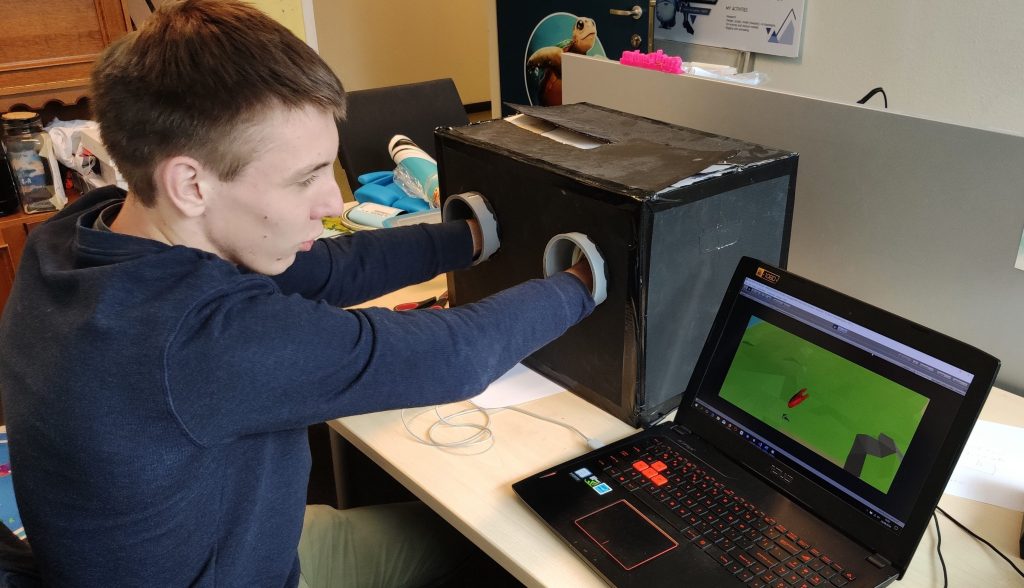13 jul Magic Box: Part 2
How cool would it be, to have a real black box, containing a virtual world which your hands can manipulate? This is what I investigate in “project Magic Box“.
In Part 1, I talked about my first explorations. Then, in the last quarter of 2019, I was fortunate to have the assistance of a Game Programming intern, Harold Mulder. This blog post discusses the work done as part of his internship.
Games for the Magic Box
Harold Mulder is a game programming student (graduate) of Alfa College Groningen. Together we first started to generate a bunch of ideas for games to be played with the Magic Box. My idea is to use the Magic Box as an (art) installation for festivals, so the game play should be limited in time (e.g., 5 minutes per level) but preferably each visit should be unique.

Also, the Box and the Leap Motion provide additional constraints:
- All player inputs should be done via the Leap Motion (my original idea to use knobs on the outside of the box to move through the world is not practical: it would involve getting one hand out of a rubber glove, turning the knob, and getting in the glove again)
- The player’s hand movements are quite restricted (the opening restricts the wrist)
- Hand gestures should be “natural”: e.g., pinching to pick up an object.
So we identified three different functions we needed to provide at least:
- To navigate through the virtual world using your hands
- To manipulate objects that are not fixed
- To manipulate (e.g., tap on) the fixed elements in the virtual world.
“Lemmington” – the game
This is the game we came up with: it is code-named “Lemmington”, since it is a game where little robots (lemmings) will destroy their own world if no one stops them. These robots are enthusiastic, but lack intelligence – if there e.g. is a flamethrower in the area, a robot will use it, and set fire to buildings it may hit …
So your goal as a player is to protect the world from its own inhabitants! You do this by identifying where the robots are in the world, what possible dangerous objects they could use, and prevent them from doing that, e.g., by picking up the robot and putting them in a safe place. Your score is the overall health of the region: how many buildings you managed to save.
But why would any dangerous objects appear in the world? Ah, but there seems to be a plane cruising around the area and dropping crates with “useful goods” for the inhabitants! (This is inspired by the idea of “cargo cults“. Apparently the robot inhabitants pray to a superior being to bring them goods to improve their world!)
(Notice that one crate opens and reveals it contains a bomb – always useful!)

Harold made a few levels, and designed all kinds of effects to be used as game play elements:
- There are axes (which robots use to chop down a house).
- Bombs, Flamethrowers, Jackhammers, Barbeques (smoke), etcetera,
- But also elements that the player can use to (temporarily) disable the robots:
- EMP (an electromagnetic pulse that stuns all power in a certain area – including the robots)
- Rain, to put out fires,
- And there are “natural disasters”:
- Volcanoes erupting!
The mini-map in the lower left corner indicates where the crates have dropped, where the robots are, how many buildings are still standing, etcetera.
Each level varies (not only in the environment) in number of houses, number of robots, and the frequency of crates arriving. This is an easy way to create a very diverse experience!


Current issues – next steps
One of the basic functionalities required is to be able to pick up the robots and drag them to other places in the virtual world:
You see that it works, but not as “cleanly” as we would want it: the robot is not firmly fixed against the hand.
By building the Lemmington game, we could test the main idea of the Magic Box in real life. The biggest issue, as it turns out, is not with the gameplay (although of course there always things to be improved) but with the Leap Motion:
- In the current setting, it is too sensitive: e.g., you tap by accident, just because you want to pick up a robot.
- Navigating through the environment requires large movements and is not intuitive (in order to move the camera forward, you have to move your hands upward. But moving your hand forward could conflict with picking up a robot)
- You want the Leap Motion to respond to smaller movements (because your arms are restricted through the openings), but on the other hand, you don’t want it to be too sensitive ….
So the next step would be, to build a new version of the Magic Box, in order to test the placement of the screen, and see if we can make the Leap Motion behave like we want it to. I’ll keep you up to date on my progress!





Sorry, het is niet mogelijk om te reageren.